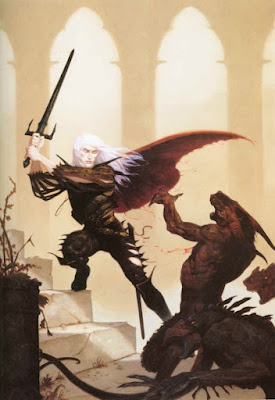Though Alex Schroeder, I came across these questions. What better way could there be to spend the dead zone of the late afternoon on New Year's Eve than to answer them? [Note: I will answer the questions as they come but I will not use the obnoxious acronym 'TTRPG'.]
First store where you bought a an RPG?
It was in a small nerdy bookshop in Tel Aviv, and it was the AD&D 2nd edition DMG. I already had some RPG books, but I am fairly sure this was the first one I actually bought. If it wasn't that particular shop, it was almost certainly the Virgin Megastore in Liverpool. It is a sign of how old I am that: a) Virgin Megastores still existed when I was an adolescent; and b) that shops like that actually sold any books, let alone RPG books, during my youth.
Favourite RPG game world?
I would probably end up plumping for Dark Sun, because it is I think the most compelling and interesting of the TSR settings - not that that is really saying a great deal. Or, if I'm allowed to cheat a bit, Middle Earth, from MERP.
A published NPC who has made a lasting impression on you
I can't say many have, partly because I don't really buy modules/adventures, and partly because...seriously? A 'lasting impression'? The main one that actually sticks in the memory is the female cleric who gets killed in the introductory Red Box Basic adventure. God, what was her name? Still brings a tear to my eye.
First RPG you bought from its creator
Assuming this includes digital purchases it would almost certainly be something by James Raggi - maybe even the Random Esoteric Creature Generator back in the day?
RPG you've played the most
I imagine it is probably 'Classic' BECMI D&D, but I did play an awful lot of Shadowrun and Cyberpunk 2020 as a youngster. If you totted up all the hours then it might end up being one of those.
A favourite RPG character you've played
One that just popped into my mind was Trout, a megalomaniacal, manipulative, Stalinesque cult-leader from an old Apocalypse World game. I suspect his personality aligned pretty closely with mine.
The RPG you've spent the most money on but never played
'Never' played is a high bar. I spent a lot of money on the oWoD games but didn't play them much. I do have some games I have never played - Cyberspace, Judge Dredd, etc. - but they didn't cost me a lot.
Favourite RPG for its art
Has to be Planescape if that counts as an RPG. I also really, really like the artistic direction behind Changeling: The Dreaming even if it lacks in execution at times.
Favourite RPG for its writing
I think I may have commented on this in an old blog entry but there is a lot to be said for the (admittedly cheesy) authorial voice in Cyberpunk: 2020 - I have a real soft spot for the in-universe quasi-hard-boiled elements especially ('Frak it, Johnny! I'm chippin' in!') I can't say I think many RPG books are brilliantly written, in the end.
Have you played a journaling game?
I'm not sure I know what one of those is. If it means a solo RPG game that you write, why not try to write an actual novel?
Have you played a hexcrawl?
Often!
Have you designed a dungeon?
Often!
Have you played a LARP?
No. LARPS are down the geek hierarchy, I'm afraid.
Favourite object one of you characters has owned
Is this a serious question?
Memorable relationship one of your characters has had
I'm now worried these questions were penned by a fourteen year old.
Do you collect RPGs by a certain designer?
I suppose the answer to this is yes, in that I think I have everything Patrick Stuart has made. Other than that, I tend not to buy many RPG materials in general. I would never use them, so I only buy things that I think would be interesting to read, beautiful to look at, or inspirational in some way.
RPG you really want to play in 2023
I'd be happy with my ongoing BECMI campaign continuing on a weekly basis, although I would love to run a bit of MERP at some point as well. Or maybe even resurrect Cyberpunk 2020.
Most memorable monster/villain you've confronted
I really liked an evil version of Father Christmas a friend invented for a one-shot long ago.
Ever experienced bleed?
I don't know what that is, nor really wish to.
How did you get into RPGs?
A friend's big brother ran a game for a group of us when we were somewhere around 11-12. I think probably 90% of people in the hobby from my generation had this experience. Then again, it depends on what the question means - I could just as easily say that Fighting Fantasy books and Warhammer got me into RPGs in the sense that they primed me to be interested in the concept.
















